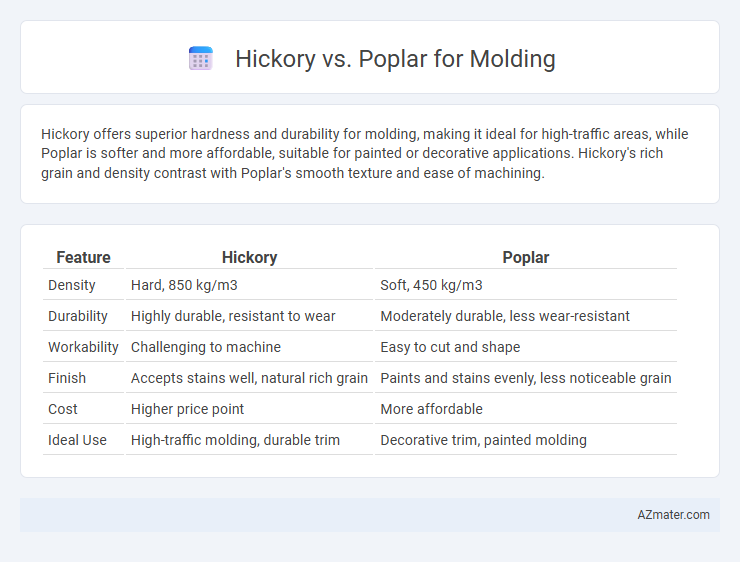Hickory offers superior hardness and durability for molding, making it ideal for high-traffic areas, while Poplar is softer and more affordable, suitable for painted or decorative applications. Hickory's rich grain and density contrast with Poplar's smooth texture and ease of machining.
Table of Comparison
| Feature | Hickory | Poplar |
|---|---|---|
| Density | Hard, 850 kg/m3 | Soft, 450 kg/m3 |
| Durability | Highly durable, resistant to wear | Moderately durable, less wear-resistant |
| Workability | Challenging to machine | Easy to cut and shape |
| Finish | Accepts stains well, natural rich grain | Paints and stains evenly, less noticeable grain |
| Cost | Higher price point | More affordable |
| Ideal Use | High-traffic molding, durable trim | Decorative trim, painted molding |
Introduction to Hickory and Poplar for Molding
Hickory and poplar are two common hardwoods used in molding, each offering distinct advantages for interior trim work. Hickory is renowned for its exceptional hardness, durability, and unique grain patterns, making it ideal for high-impact areas and projects requiring longevity. Poplar, on the other hand, is favored for its smooth texture, easy workability, and affordability, providing a cost-effective option for painted moldings and detailed designs.
Wood Characteristics: Hickory vs Poplar
Hickory offers exceptional hardness and durability, making it ideal for high-traffic molding applications, with a Janka hardness of 1820 compared to Poplar's softer 540 rating. Poplar is lighter and easier to work with, featuring a fine, uniform texture that readily accepts paint and stain, whereas Hickory displays a more pronounced grain with color variations ranging from pale to rich brown. The density and toughness of Hickory provide superior resistance to dents and wear, while Poplar's lighter weight and smooth surface allow for quicker installation and finishing.
Appearance and Grain Pattern Comparison
Hickory molding features a distinctive, bold grain pattern with rich variations in color from pale to dark brown, providing a rustic and natural aesthetic. Poplar molding offers a more subtle, uniform grain with a smoother texture and lighter tones, often greenish or creamy white, ideal for painted finishes. The contrasting grain complexity between Hickory's pronounced streaks and Poplar's even appearance makes Hickory preferred for showcasing wood character, while Poplar is favored for a clean, versatile look.
Durability and Strength Analysis
Hickory exhibits exceptional durability and superior strength compared to poplar, making it ideal for molding applications requiring long-lasting performance. With a Janka hardness rating of approximately 1820, hickory resists dents and wear far better than poplar, which has a Janka rating near 540. The dense grain structure of hickory provides enhanced resistance to impact and deformation, whereas poplar's softer composition is more prone to damage under stress.
Workability and Ease of Installation
Hickory offers exceptional durability but is denser and harder to work with, requiring more effort for cutting and shaping moldings. Poplar is softer and lightweight, making it easier to mill, nail, and install, which speeds up the installation process. Poplar's smooth finish accepts paint well, whereas Hickory's grain often requires additional sanding or staining for a refined look.
Cost Differences Between Hickory and Poplar
Hickory molding typically costs more than poplar due to its superior hardness, durability, and natural grain patterns that appeal to high-end interior applications. Poplar, being a softer wood with a more uniform texture, is generally less expensive and favored for budget-friendly projects requiring easier machining and painting. Cost differences between hickory and poplar moldings can range from 30% to 50%, influenced by supplier availability and regional pricing variations.
Finishing Options and Paintability
Hickory offers a dense grain structure that accepts stains and finishes evenly, making it ideal for clear coatings or darker stains that enhance its natural texture. Poplar features a smoother, softer surface with fewer grain variations, allowing for superior paint adhesion and a uniform finish, especially with light or bright colors. Both woods respond well to primers, but poplar's consistent texture ensures less blotching and easier topcoat application for molding projects.
Best Applications for Hickory and Poplar Molding
Hickory molding is ideal for high-traffic areas and projects requiring exceptional durability due to its hardness and resistance to wear, making it perfect for baseboards, staircases, and door frames that demand long-lasting strength. Poplar molding excels in painted applications because of its smooth grain and ease of finishing, making it the preferred choice for decorative trim, crown molding, and interior accents where a sleek, uniform paint surface is desired. Selecting hickory provides structural support and rustic appeal, while poplar offers versatility and cost-effectiveness in detailed, painted woodworking projects.
Maintenance and Longevity Factors
Hickory is renowned for its exceptional durability and resistance to wear, making it a superior choice for molding that requires low maintenance and long-lasting performance. Poplar, while more affordable and easier to work with, tends to be softer and susceptible to dents and scratches, necessitating more frequent upkeep and refinishing. In terms of longevity, hickory's dense grain structure ensures greater resilience against environmental factors, extending the lifespan of molding installations compared to poplar.
Choosing the Right Wood for Your Molding Project
Hickory offers exceptional durability and a striking grain pattern, making it ideal for moldings in high-traffic areas or homes seeking a rustic or traditional aesthetic. Poplar, known for its smooth texture and affordability, is easier to paint and works well for detailed moldings where a uniform finish is desired. Selecting hickory ensures long-lasting strength and visual interest, while poplar provides versatility and cost-effectiveness for intricate trim work.

Infographic: Hickory vs Poplar for Molding
 azmater.com
azmater.com